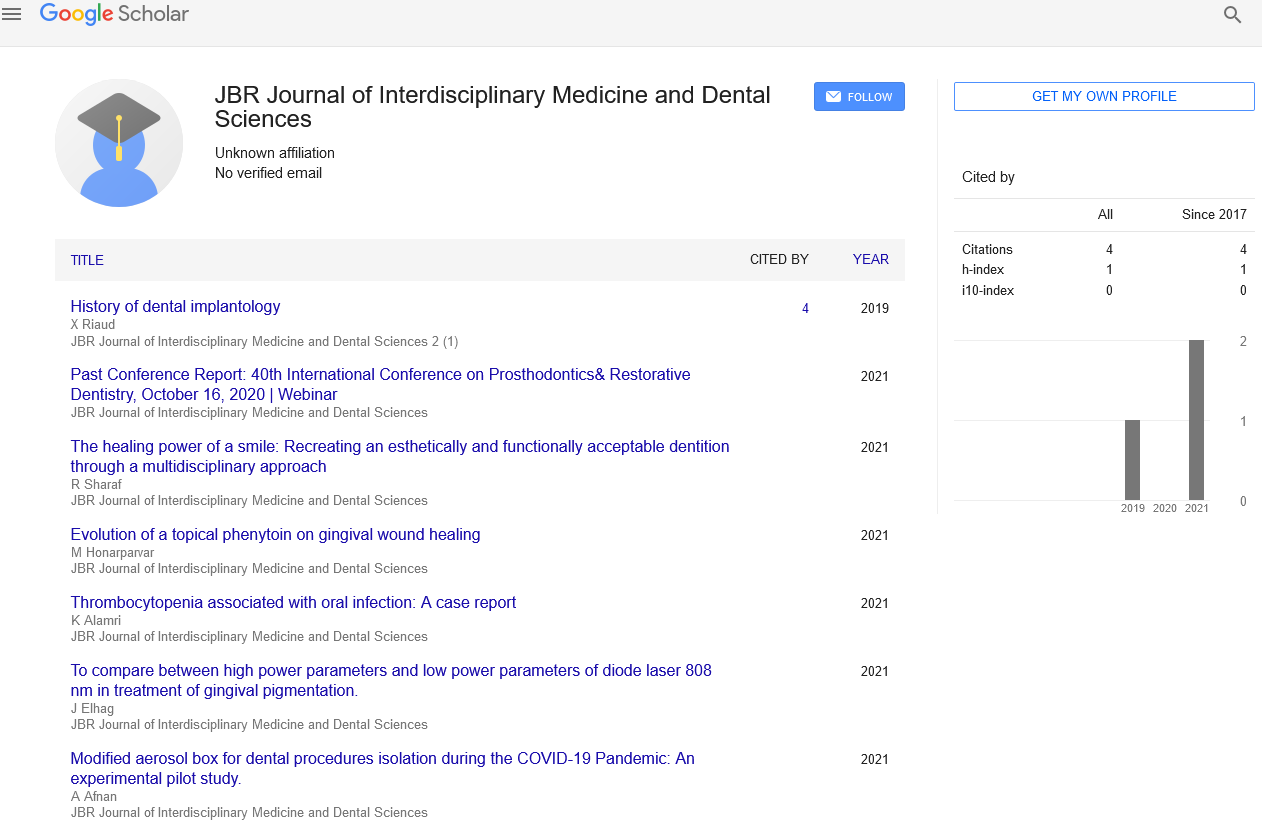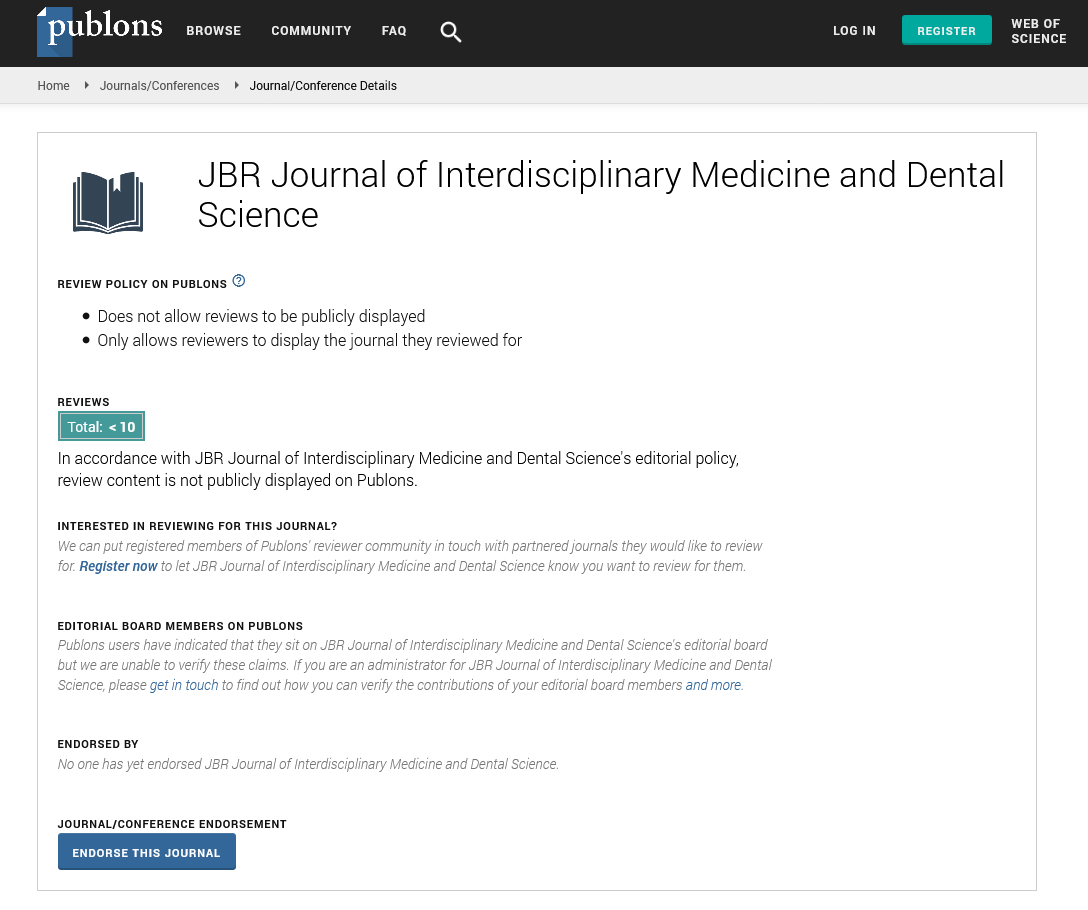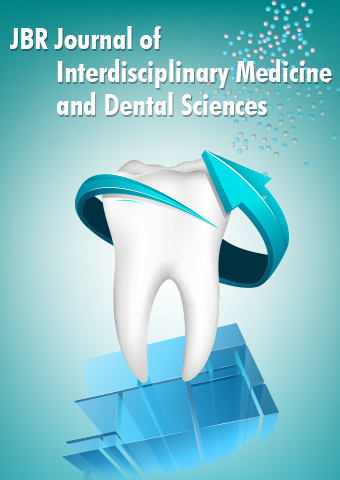Review Article - JBR Journal of Interdisciplinary Medicine and Dental Sciences (2023) Volume 6, Issue 1
Periodontal disease
Alice Armitage*
Discipline of Periodontics, Sydney
Discipline of Periodontics, Sydney
E-mail: armitagealice@rediff.com
Received: 02-Jan-2023, Manuscript No. JIMDS-23-85878; Editor assigned: 04-Jan-2023, PreQC No. JIMDS-23-85878(PQ); Reviewed: 18-Jan-2023, QC No. JIMDS-23-85878; Revised: 23-Jan-2023, Manuscript No. JIMDS-23-85878(R); Published: 30-Jan-2023, DOI: 10.37532/2376- 032X.2023.6(1).15-18
Abstract
Since at least 5000 BC, periodontal disorders have been recognised and treated. The apparent disparities in how periodontal diseases manifest have long been acknowledged by clinicians, who have made an effort to categorise these illnesses. Aetiology, pathophysiology, and therapy of illnesses may now be identified using structures developed by physicians using disease categorization systems that have emerged. It enables us to plan efficient care for the illnesses of our patients. The cause of the problem and the best evidence-based treatment are offered to the practitioner when a disease has been identified and characterised. Health care providers may communicate effectively utilising a common language because to shared categorization systems. Early categorization attempts were based on the clinical features of the illnesses or beliefs regarding their origin [1]. There was no evidence to back up their attempts. The foundation of categorization was established by conventional pathology as scientific understanding grew. Systems of classification based on our understanding of the numerous periodontal diseases and the host response to them have since followed this. Periodontal disease classification, however, has proven difficult. As research has increased our understanding of these illnesses over the course of the last century, physicians and researchers have struggled with the issue and have met frequently to review or improve the categorization of the many types of periodontal disease. As a result, adjustments and updates have been made often. However, a categorization shouldn’t be thought of as a long-lasting structure. It must be flexible enough to adapt and develop when new knowledge is discovered. It is anticipated that categorization schemes will evolve over time. The categories of periodontal diseases in the past and today are examined in this overview [2].
Introduction
Periodontal disease is a condition, or more likely a group of conditions, that affects the periodontal tissues and causes alveolar bone to lose its attachments. In some individuals, but not all, the normal course of periodontal disease leads to tooth loss. However, periodontal disease involves a broader range of illnesses than only periodontitis, and recognising these illnesses necessitates a diagnosis [3].
The detection of a disease is known as a diagnosis. The identification of numerous periodontal tissues signs and symptoms that indicate a change from health allows for the clinical diagnosis of periodontal disease. Understanding what constitutes periodontal health is essential to the diagnosis of periodontal disease. Only the gingival tissues of the healthy periodontium, which is described as being stippled, light pink or coral pink in the Caucasian, with varying degrees of pigmentation in other races, may be immediately visible. It is closely adapted to the underlying tissues, and the area where it touches the tooth has a knife-edge border. If there is no disease, the gingival edge is found at the intersection of the cement and enamel [4]. It has a scalloped edge structure that is highest between the teeth, where it makes up the interdental papilla, and lowest between the buccal and lingual surfaces. Where it touches the tooth, there is a 1-3 mm-deep gingival crevice that is healthy. On mild probing, there is no blood coming from the crevice. A tiny quantity of interstitial fluid and gingival crevicular fluid will be seen in the fissure in healthy teeth. The free gingival margin is made up of the crevice’s lateral wall [5]. The connected gingival, which stretches from the mucogingival junction to the free gingival’s most apical extent, is 1 to 9 mm wide and has a stippled surface. It is a keratinized mucosa that is well suited to withstand damage and is an immobile tissue that is strongly connected down to the bone as a mucoperiostium. The alveolar mucosa, which is freely movable and covered by a non-keratinized epithelium, is located apical to the mucogingival junction and continuous with the mucosa that lines the inside of the mouth. According to widespread consensus, the alveolar mucosa performs poorly as a marginal tissue, and mucogingival issues may exist in regions where the gingivas are not linked. Deviations from this idea of the disease-free periodontium may indicate its presence [6].
In order to help doctors identify diseases in relation to their origin, pathophysiology, and treatments, systems of disease categorization have emerged. It enables us to plan a disease-specific treatment plan for our patients. The cause of the problem and the best evidence-based treatment are offered to the practitioner when a disease has been identified and characterised. Additionally, classification systems enable researchers and physicians worldwide to interact in a single language [7].
The American Academy of Periodontology’s categorization systems for periodontal disease are the most widely used (AAP). The Academy has struggled to recognise and categorise the numerous types of periodontal disease throughout the course of the previous century as research has increased understanding. As a result, there have been several modifications and alterations, which have led to considerable misunderstanding. However, a categorization shouldn’t be thought of as a long-lasting structure. It must be flexible enough to adapt and develop when new knowledge is discovered. The evolution of categorization systems must be anticipated, even if practitioners may find this puzzling and possibly irksome [8].
Historical context
Periodontal disease has been recognised and treated since ancient times. Ancient Egyptian and Chinese manuscripts have descriptions of treatments, which would show that periodontal illnesses were understood maybe 5000 years ago. In the tenth century, Abu I Quasim, commonly known as Abuccusis of Cordova, Spain, produced the earliest modern works. The earliest dental textbook, “The Surgeon Dentist,” by Pierre Fauchard, was published in 1728. More recently, John Hunter, who wrote “The Natural History of the Human Teeth” in 1771 and “A Practical Treatise on the Diseases of the Teeth” in 1778, described the management of periodontal disease. Hunter supplied the scientific underpinnings of contemporary dentistry despite the fact that there was already a sizable amount of literature on the subject—possibly more than 450 treatises—in existence before this one. Von Leeuwenhoek identified the presence of germs around the teeth in the 17th century. He called what he observed “animicules” and implied that they were diseases. When he characterised the action of vinegar upon the animicules in vivo and in vitro, he was also likely the first person to discover the protective effect on bacteria of the features of biofilms. His results went unnoticed, and it wasn’t until the latter half of the 19th century—following Pasteur, Koch, and Lister’s key work on the germ theory of disease—that the bacterial aetiology of periodontitis was acknowledged. Adolph Witzel (1847–1906) may have been the first to link bacteria to periodontal disease, but WD Miller was the first real oral microbiologist (1853–1907). Up until that point, it was generally believed that systemic causes played a substantial role in periodontal disease. But many practitioners were aware of the significance of local circumstances. The role of local irritants in the aetiology of periodontal disease was clearly recognised by John W. Riggs (1811–1855), a notable expert on the treatment of periodontal disease and coincidentally Mark Twain’s periodontist. The elimination of local rather than systemic causes was the focus of his comprehensive, albeit contentious, lectures on the treatment of periodontal disease, despite the fact that he rarely wrote. Periodontitis was formerly known as “Riggs’ sickness,” especially in America [9].
Little was known about the origin and pathophysiology of periodontal diseases in the 19th century. Without any foundation in fact, classification was done on the basis of a patient’s clinical features or hypotheses about how they got that way. Early in the 19th century, the term “pyorrhea alveolaris”—this literally meant “pus leaking out of the alveolus”—was used to characterise periodontitis. This indicates that periodontitis’ infection of the bone. Sadly, this was erroneous, but it had a long-lasting impact on periodontitis therapy, leading to the use of flap surgery to remove contaminated marginal bone [10].
Early categorization efforts are a reflection of the clinical features paradigm, as described by Armitage, which was popular from 1870 to 1920. He identifies three main paradigms of understanding—the clinical features paradigm, the classic pathology paradigm, and the infection/host response paradigm—that have had a significant impact on our efforts to categorise periodontal disorders. The traditional pathology paradigm dominated from 1920 to 1970, while the infection/host response paradigm has dominated from 1970 to the present. Clinically, it had long been acknowledged that there appeared to be many forms of periodontal disease, and efforts had been made to categorise them. Gottlieb made an attempt to divide the widespread condition known as pyorrhea alveolaris in 1921 into four distinct conditions: schmutz pyorrhea, also known as filth pyorrhea, paradontal pyorrhea, which is caused by a deepseated infection in the gingival crevice that is unaffected by hygiene measures, diffuse atrophy of the alveolar bone, and accelerated eruption. Fish discussed two types of pyorrhea: pyorrhea profunda, which had isolated deep pockets but minimal overall deepening of the sulcus surrounding most teeth, and pyorrhea simplex, which had progressive equal deepening of the sulcus. For disease processes that principally affect the gingival tissues, the pericementum, or the alveolar bone, Stillman and McCall advocated for the labels gingivitis, ulatrophia, alveoloclasia, and pericementoclasia. Box categorises chronic periodontitis into complex and simplex, and forcefully asserts that occlusal trauma plays a significant role in the aetiology of complex. Intriguingly, Box cites a 1926 article by R. Morse Withycombe, the first periodontist to practise in Sydney, Australia, as support for his theory.
Conclusion
Despite significant research efforts to create new technologies that enhance diagnostic capability, periodontal diagnosis is still conducted using classic diagnostic techniques based on clinical indicators of inflammation, probing depths, and clinical attachment loss. Gingival stability is strongly predicted negatively by gingival noninflammation and short probing depths. When treating patients, the doctor should work toward this aim. Classification is often a part of illness diagnosis. Classification schemes are always changing. Periodontal disease categorization is challenging, and every system that has been developed to yet has flaws and detractors. Van van Velden stated that the 1999 reclassification was ineffective and proposed a classification based on age, which seems to be a condensed form of the 1989 AAP classification, followed by classifications based on extent, severity, and clinical features. Any patient with periodontitis might potentially have their clinical diagnosis of the disease made using this categorization.
While acknowledging that the 1999 World Workshop tried to create a categorization from an evidence-based approach, Milward and Chapple critiqued the 1999 classification as being overly complicated and unsuitable for standard general dentistry practise. From an epidemiological perspective, Lopez and Baelum contend that there is little justification for the use of intricate classification schemes and favour a method based on straightforward clinical attachment loss measurements, such as 3 mm, etc., a straightforward method that does not attempt to distinguish between various types of periodontitis.
Why is defining periodontal disease so challenging and contentious? The heterogeneity of the clinical presentation and our ignorance of the real nature of the distinctions between the many clinical manifestations of the disease are the cause and the solution, respectively. We make an effort to categorise utilising data based on the various illnesses depicted and the host response. However, most of the time our knowledge is lacking or unclear. The conviction that we had arrived at a stage where we could properly discern between the various illness presentations in a scientific manner in the 1980s has virtually vanished. It is noteworthy that localised juvenile periodontitis (LJP), a condition that has long been acknowledged as a distinct or separate disease entity due to its clinical features, microbiological components, and host response, all of which have been well documented, has been reclassified as localised aggressive periodontitis. It appears that this was done to comply with the classification’s specified criteria, especially the elimination of the agerelated focus. Although the circumpubertal age of onset is an essential component of the illness description and its deletion does not appear to have been a progressive step, I have yet to observe a LJP in anybody other than a juvenile. We should also take into account the possibility that there may be a single periodontitis with various clinical manifestations in several hosts. The classification method presented by the “1999 International Workshop for a Classification of Periodontal Diseases and Conditions,” according to Armitage’s scholarly essay on classification, “has remedied some of the difficulties connected with the previous system that had been in use since 1989.” However, the new system has to be improved until there are enough fresh data to warrant changes because it is far from ideal. According to him, conventional disease labels like “chronic periodontitis” are really constellations of polygenic and polymicrobial diseases whose clinical manifestation is affected by significant environmental and host-modifying factors. It appears that we are attempting to categorise diseases for which we do not have enough information. Surprisingly, the current categorization of periodontitis appears to be a reversion to simplex and complicated. It is highly likely that we will continue to witness periodic reclassifications until we have a better grasp of the aetiology, the bacteria linked with various periodontal infections, and the biology and genetics of periodontal illnesses.
References
- Phramor L. Validity of claims made in weight management research: a narrative review of dietetic articles. Nutrition Journal. 9, 30 (2010).
- Long Z, Huang L, Lyu J et al. Trends of central obesity and associations with nutrients intake and daily behaviors among women of childbearing age in China. BMC Women's Health. 22, 12 (2022).
- Melina V, Craig W, Levin S et al. Position of the Academy of Nutrition and Dietetics: Vegetarian Diets. J Acad Nutr Diet.116, 1970-1980 (2016).
- Mueller-Stierlin AS, Cornet S, Peisser A et al. Implications of Dietary Intake and Eating Behaviors for People with Serious Mental Illness: A Qualitative Study. Nutrients. 14, 2616 (2022).
- Johnson VR, Washington TB, Chhabria S et al. Food as Medicine for Obesity Treatment and Management. Clinical Therapeutics. 44, 671-681 (2022).
- Partridge L, Deelen J, Slagboom PE et al. facing up to the global challenges of ageing. Nature. 561, 45-56 (2018).
- Coman V, Vodnar DC. Gut microbiota and old age: Modulating factors and interventions for healthy longevity. Experimental Gerontology. 141, 111095 (2020).
- DeJong EN, Surette MG, Bowdish DM et al. the Gut Microbiota and Unhealthy Aging: Disentangling Cause from Consequence. Cell Host & Microbe. 28, 180-189 (2020).
- Warman DJ, Jia H, Kato H et al. The Potential Roles of Probiotics, Resistant Starch, and Resistant Proteins in Ameliorating Inflammation during Aging (Inflammaging). Nutrients. 14, 747 (2022).
- Fong BY, Chiu WK, Chan WF et al. A Review Study of a Green Diet and Healthy Ageing. Int J Environ Res 18: 8024 (2021).
Indexed at, Google Scholar, Cross Ref
Indexed at, Google Scholar, Crossref
Indexed at, Google Scholar, Crossref
Indexed at, Google Scholar, Crossref
Indexed at, Google Scholar, Crossref
Indexed at, Google Scholar, Crossref
Indexed at, Google Scholar, Crossref
Indexed at, Google Scholar, Crossref


